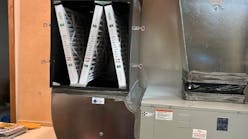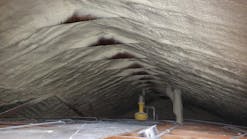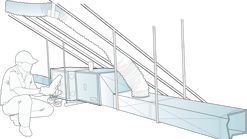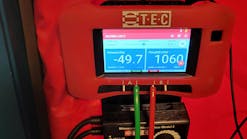The rolling mountains of northeastern Pennsylvania make a beautiful setting for a home. The area is deep green in the summer, ablaze with color in the fall, and covered in a thick blanket of snow in the winter. The four seasons climate, however, means comfort challenges, and the owners of this home desired the ultimate in comfort, indoor air quality (IAQ), and efficient system operation. To get that, they entrusted the mechanical systems work at their new home to Quality Home Comfort Award winner T.E. Spall & Son, Inc.
“Most mechanical contractors do a good job of basic design and installation. But this home isn't suited to a ‘cookbook’ type of formula,” says John Dziedzina, the owner of this beautiful 8,291 sq.ft. home. “Tom Spall approached this job the way an engineer would. His system design really impressed me, and his crews did a very professional job on the installation.”
Dziedzina, who had been involved with energy audit work in the 1970s, was aware of his options when he selected T.E. Spall & Son.
“We knew we wanted a geothermal system because of the comfort, quiet operation, and energy efficiency geothermal offers. We also knew that in order for the system to work the way it should and provide the energy savings that it should, it would have to be designed right,” Dziedzina says. “Engineering expertise is critical for a complex system like this, with seven zones, combination hot air and radiant flooring, and a back-up boiler system. We knew of the contractor's ability to provide good engineering design.”
Thomas E. Spall, president of T.E., Spall & Son, was happy to provide the expertise.
“This project took four-plus years from its conception, design, installation, and final completion,” Spall says. “We were part of the design team from the start. The customer was an Energy Saving Service Plan customer of ours, and from positive experiences with us, named us as the proprietary HVAC company to the job.
“The homeowner stressed the importance of comfort, indoor air quality, and efficiency. That's why he decided on geothermal. He accepted nearly all of the design recommendations that we presented to him — not all upfront, but by completion, most were accepted,” Spall adds.
Architecture and aesthetics were of major importance on this project. The homeowner did not want to see or hear the home's mechanical systems. Spall calculated net free area requirements, and had woodworkers build custom supply and return grilles to blend in with the custom woodwork. In many areas the returns were built into the custom-made furniture units. Because of the use of the home for entertaining on occasions the homeowner asked that each of the second floor bedroom suites be zoned for use as needed.
The basement area required ductwork, piping and related wiring in an area where space was at a premium. After performing Manual J 8th edition load calculations and Manual D duct sizing calculations, Spall custom designed the duct systems and piping to meet design air and water flows, and verified the performance with system balancing and testing upon completion of the project.
Three Ground Loop Systems
The landscaping requirements led to the decision to use vertical geothermal earth loops. The loop design was performed with WaterFurnace loop and pressure drop design software. Spall's team installed three independent ground loop systems serving six geothermal heat pumps, with each having its own flow center to the earth loop.
“Transitional weather seasons, the spring and fall, can find a home in the Northeast needing heating in the morning and cooling in the afternoon, and we had a concern about possibly overheating the radiant spaces due to the fact it had ductwork as well as floor warming,” Spall says. “To overcome this, we chose to use tekmar temperature controllers to control floor temperature and also take outdoor air temperature into consideration and utilize warm weather shutdown.
“We embedded a piece of 3/8-in. copper into the mortar bed below the tile. This was accessible from the basement and allowed us to insert the sensor into the tubing and accurately sense floor temperature. The controller will not allow the floor to warm when the outdoor air temperature is above 72F. When the outdoor air temperature is below 72F, the controller will maintain the floor temperature of approximately 84F,” Spall explains.
The homeowner wanted an emergency backup generator system. This posed two major issues with our system: the requirements to run the compressors increased the size of the generator dramatically, and the requirements for the electric resistance supplemental/emergency heat also did the same.
Page 2 of 2
Spall's solution was to design and install an automatic control system that isolates the compressor from operation during power outages and generator operation, but still allow the ECM fan motor and all other controls to operate. Spalls' team also installed an emergency backup hot water boiler and added a hot water coil to each air handling unit for emergency and supplemental heat, thus reducing the electrical demand on the generator.
Boiler Balancing Act
The boiler is a high efficiency condensing type, and is equipped with an outdoor air temperature sensor to take the boiler offline above the set point. “Since we had the boiler available and its operation for supplemental and emergency heating would have it spending the majority of its life inoperable, we decided to install a 100-gal. indirect domestic hot water heater that would maximize the hot water generation capability of the boiler to supply the seven full baths in the house, and also provide the boiler with a more useful life,” Spall says. “The venting and combustion air intake were an issue, as we needed to put that somewhere where it would be out of sight. We ended up solving the issue by building it into the masonry work as the chimney was being built.”
All of the HVAC systems in this home have 30% media filters. The custom fabricated, galvanized steel supply and return ducts are designed with high efficiency fittings, and flex duct was used for straight runs only, with no turns. All ductwork was sealed and insulated with 1.5-inch duct wrap.
All testing and balancing was done to National Comfort Institute (NCI) standards; T.E. Spall & Son has eight technicians that are NCI-certified. Combustion testing was performed and the equipment was adjusted for maximum performance and safe operation. Air balancing was also performed to NCI standards, and the geothermal system was thoroughly commissioned and balanced.
“We really believe in training our team,” Spall says. “In addition to our NCI certification, we belong to International Service Leadership (ISL). We focus on training to help keep our people ahead of the curve.
“The project employs the best industry design, installation and performance testing practices to ultimately measure the results of our design intentions, as well as utilizes the highest efficiency earth-friendly systems available today,” Spall says. “We're very proud of it.”
Craig Karkoska, head of the custom home division for the home's general contractor, C. Raymond Davis, praised T.E. Spall & Son's work on this project. “Tom was very professional and his company's work is very good. His team was good to work with during the installation, and they were very conscientious when it came to starting the systems up. They balanced and fine-tuned everything.”
“When all is said and done, I'm very impressed with how great it feels inside the house,” adds Dziedzina. “No matter what the weather is doing, there are no hot or cold spots.”
That being case even in the wide range of Northeastern Pennsylvania's four-seasons climate, one is left to wonder if this Quality Home Comfort Award represents something more … such as a triumph over nature? Actually, more of a partnership with it, thanks to the geothermal work of T.E. Spall & Son.
EQUIPMENT LIST
- WaterFurnace Envision 5-ton water-to-air geothermal unit, two-speed with ECM and desuperheater
- 2 WaterFurnace 3-ton water-to-air geothermal units, two-speed with ECM)
- WaterFurnace 3-ton geothermal split system
- Trane two-speed air handling unit
- Honeywell TZ4 three-zone control system
- WaterFurnace 2-ton geothermal split system with two-speed air handler
- Water Furnace 3½-ton water-to-water geothermal unit for radiant heating, coupled with an HSS flow center for radiant distribution
- Weil-McLain Ultra 155 high efficiency condensing boiler
- Reflectix double bubble foils poly insulation between sub-grade and slab
- Zurn PEX Thermal Track radiant panel
- Wirsbo in-slab radiant panels in basement slab
- tekmar control panels with outdoor air sensor
- tekmar slab sensor for tile floor slab floor warming
- Southwark 45 degree entry, high efficiency duct fittings
- Anemostat grilles, registers, and diffusers
- Hart & Cooley grilles, registers, and diffusers









